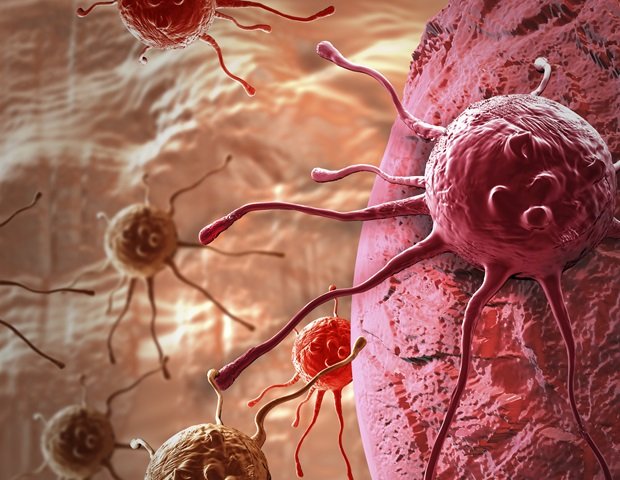The Golgi apparatus modifies, sorts and packages proteins to be shipped to their final destinations, whether they are inside or outside the cell.
It is a key function, but poorly studied in the context of cancer immunology, especially compared to other organelles such as mitochondria or the endoplasmic reticulum.
“So we were interested in looking a little bit more at the Golgi apparatus. It’s obviously an important organelle. How does it change or what is its role in T cells in terms of fighting cancer?” said Nathaniel Oberholtzer, MD/Ph.D. student who worked in the laboratory of Shikhar Mehrotra, Ph.D., co-head of the Cancer Biology & Immunology Research Program at MUSC Hollings Cancer Center and scientific director of the Center for Cellular Therapy at MUSC College of Medicine.
As it turns out, the healthy functioning of the Golgi apparatus has a lot to do with how well T-cells work at killing cancer cells. Understanding how a signaling pathway alleviates Golgi stress, allowing it to perform properly, points to a potential new therapeutic target for researchers to pursue to boost T-cells. Not only that, but Oberholtzer’s research shows how the Golgi could be used as a biomarker to select the strongest T-cells for immunotherapy.
Oberholtzer, as first author, and Mehrotra, as senior author, along with a team of Hollings scientists published the research this month in Science Advances.
T-cells, part of the immune system, can kill cancer cells. CAR-T cells are T-cells that have been modified in the laboratory to attach to proteins on the surface of a person’s cancer cells. CAR-T cells are custom-made for each patient.
Both T-cells and CAR-T cells can be “exhausted” in the hostile tumor microenvironment. Mehrotra’s lab is looking at ways to boost these cells so they can fight cancer longer.
The whole tumor microenvironment is favorable for the tumor itself, but not for the other cells that try to get in there.”
Shikhar Mehrotra, Ph.D., co-head of the Cancer Biology and Immunology Research Program at MUSC Hollings Cancer Center
Just like humans, cells are constantly under stress – stress from biochemical reactions that have become unbalanced and mechanical stress from movement. Temporary stress can be good. Stressing your muscles through exercise strengthens them, and transient stress on the cells can trigger a response that ultimately strengthens them.
“But if that stress stays there, as it does in the tumor microenvironment, the cells are just under constant stress, and that will lead to a very different phenotype and death,” Mehrotra said.
However, the researchers found that treating the Golgi apparatus with hydrogen sulfide created T-cells that could require more stress.
“Hydrogen sulfide is a gaseous signaling molecule that is present in almost all types of mammalian cells. Typically, it is a byproduct of different cellular processes, but it has actually been shown to have very important signaling roles as well,” Oberholtzer said.
“It can modify proteins through a process called sulfidation, where it modifies cysteine residues and can change their activity.”
In this work, Oberholtzer found that this sulfation process, by modifying a protein called Prdx4 within the Golgi apparatus, provides protection in an oxidative setting.
“When you have the stressors that the tumor microenvironment puts on T-cells, you get a disruption or fragmentation of the Golgi apparatus where it’s basically unable to do its job. Hydrogen sulfide protects against that disruption,” Oberholtzer said. .
Examining this protective effect then led the researchers to take a closer look at the Golgi apparatus itself.
“Essentially, if you just use the Golgi apparatus as a simple indicator, if T cells have a lot of Golgi versus less, the ones with more Golgi are much more potent at killing cancer cells and controlling tumors,” Oberholtzer explained.
Using cell sorting technology at the Flow Cytometry & Cell Sorting Shared Resource at Hollings, the researchers sorted T-cells according to the amount of Golgi they contained. The top 30% was called Golgi-hi and the bottom 30% was called Golgi-lo.
“Essentially, all high-Golgi-expressing cells have a very different phenotype. They are less exhausted and are much more potent at controlling tumors,” Mehrotra said.
This preclinical work suggests that sorting T-cells into Golgi-hi and Golgi-lo and reinfusing only Golgi-hi cells into a patient would create a better chance of tumor control.
“Right now, we’re working to do some validation studies at the Cell Therapy Center so we can potentially start a clinical trial to see if this also has translational potential,” Oberholtzer said.
More work is also needed to understand the role of Golgi stress when all organelles in a cell are under stress due to the tumor microenvironment.
Source:
Journal Reference:
Oberholtzer, N., et al. (2024). The H 2 S-Prdx4 axis moderates Golgi stress to enhance the immunotherapeutic response of tumor-reactive T cells. Advances in Science. doi.org/10.1126/sciadv.adp1152.
